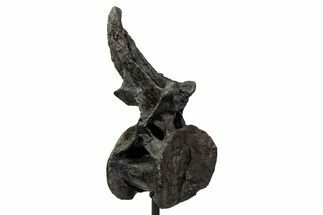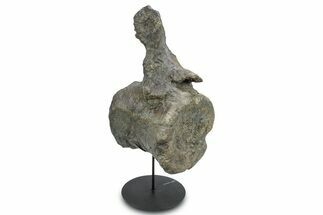This Specimen has been sold.
Composite Ceratopsian Toe - Alberta (Disposition #000028-29)
First, a note on the legality of this fossil. Alberta has very strict laws pertaining to fossil collection. Fossils may not be removed from the province of Alberta without permission from the government. To gain ownership of a fossil, you must be issued a Disposition Certificate from Alberta's Royal Tyrrell Museum. Only a few fossil types are currently eligible for disposition: mostly ammonites, petrified wood, leaves and fossil oysters.
This specimen is part of a collection of dinosaur material that was collected by a single individual (Steve Walchina) decades ago prior to the current law. Because it was collected before the law went into effect, the collection was "grandfathered" in. The collection was reviewed by the Royal Tyrrell Museum and a disposition certificate issued for portions of it that were not considered scientifically significant. This moved the fossils into private ownership and allowed them to be removed from the province. The disposition certificate (#000028-29) is on file with the Royal Tyrrell Museum. This makes the small amount of Alberta dinosaur fossils we recently acquired from this collection some of the only legal Alberta dinosaur material on the market.
This specimen is part of a collection of dinosaur material that was collected by a single individual (Steve Walchina) decades ago prior to the current law. Because it was collected before the law went into effect, the collection was "grandfathered" in. The collection was reviewed by the Royal Tyrrell Museum and a disposition certificate issued for portions of it that were not considered scientifically significant. This moved the fossils into private ownership and allowed them to be removed from the province. The disposition certificate (#000028-29) is on file with the Royal Tyrrell Museum. This makes the small amount of Alberta dinosaur fossils we recently acquired from this collection some of the only legal Alberta dinosaur material on the market.
This is a nicely preserved set of four Ceratopsian toe bones (phalanges) from the Horseshoe Canyon Formation of Drumheller Valley, Alberta. The bones are articulated, however the toe is a composite, consisting of bones from separate Ceratopsians. There are more than half a dozen species of Ceratopsians found in this formation including (Anchiceratops, Pachyrhinosaurus, etc) so it would be impossible to identify isolated bones such as this, down to the species or even genus level.
The proximal phalanx measures 2.6" wide, the intermediate phalanxes are 2.6" and 2.25" wide, while the distal phalanx measures 2.2.4 x 2.1". There are repaired cracks through the proximal phalange, restoration along the distal articulation point of the distal-most intermediate phalanx and there are two repaired cracks through the distal phalanx.
This toe comes with a richer display case
Ceratopsians are a group of plant-eating dinosaurs from the Cretaceous characterized by a bony frill on the back of the skull and a unique upper beak bone, called a rostral. Ceratopsians ranged in size from 1 meter (3 ft) and 23 kilograms (50 lb) to over 9 meters (30 ft) and 9,100 kg (20,100 lb). Triceratops is by far the best-known ceratopsian to the general public.
SPECIES
Unidentified Ceratopsian
LOCATION
Drumheller Valley, Alberta, Canada
FORMATION
Horseshoe Canyon Formation
SIZE
2.4 x 2.1" Distal Phalanx
CATEGORY
SUB CATEGORY
ITEM
#129392
We guarantee the authenticity of all of our specimens.
 Reviews
Reviews















